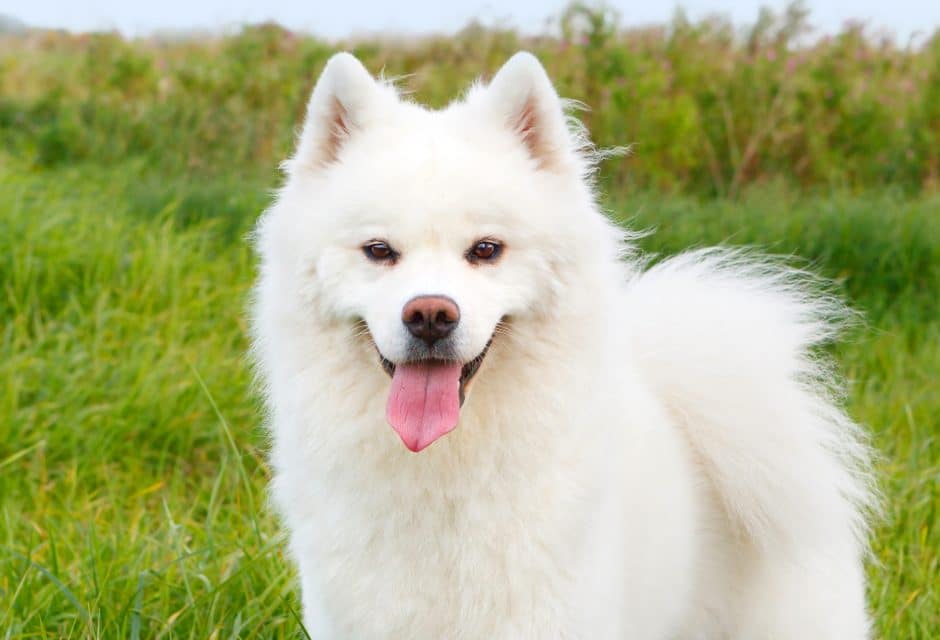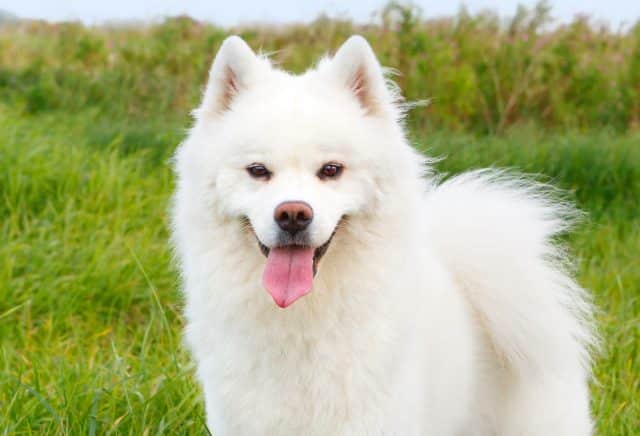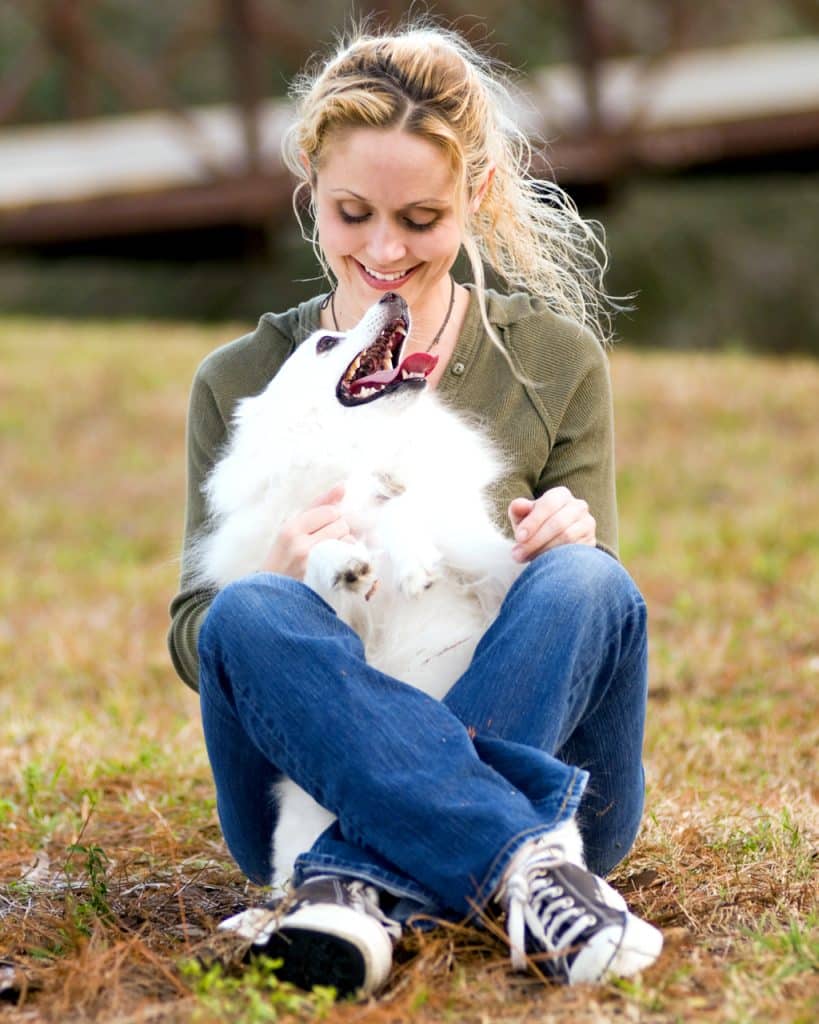

The American Eskimo Dog
Clever, kid-friendly, and among the most trainable of breeds, the Eskie is the complete brains-and-beauty package

With that glorious coat, adorable ears, and dark, almond-shaped eyes, it would be easy to focus solely on this dog’s good looks. But the American Eskimo Dog’s keen expression offers a glimpse of what lies beneath. This breed is inquisitive, intelligent, loyal, and loaded with personality. Is the American Eskimo Dog right for you?
Notwithstanding his name, the American Eskimo Dog’s development has no connection to northern indigenous peoples. In fact, he hails from Germany. The Eskie, as the breed is commonly known, is a member of the Spitz family—a group of dogs whose development began 6,000 years ago with a variety of Nordic dogs who were used for sledding, hunting, guarding, and general-purpose work on farms and homesteads. Among the Spitz breeds are several northern sledding dogs, as well as the Keeshond, the Pomeranian, the Shiba Inu, and others that were bred for harsh climates.
Spitz (German for “pointed”) breeds typically have a somewhat wolf-like appearance. Common physical traits include pointy ears, eyes that are more almond-shaped than round, double coats, and a tail that is carried over the back.

Photo Stephaniellen/Shutterstock
The American Eskimo Dog was developed in Germany. Prized as a versatile working dog, the Eskie helped farmers with general-purpose tasks, guarding, hunting, and herding. At the same time, this was always a dog who lived in the home as a member of the family.
So devoted were the Germans to these dogs that, when they immigrated to North America in the 19th century, they brought their dogs with them. At this time, the breed was known as the German Spitz and remained as such until the end of World War I. Anti-German sentiment was so widespread at that time, fanciers agreed a name change was in order. Ultimately, the breed was renamed the American Eskimo Dog, after the name of an Ohio kennel.
Around the same time, the breed started to gain in popularity, owing to their participation in various circus shows throughout the United States. Beautiful, clever, and extremely agile, they were natural performers. Their tricks and feats delighted crowds. One dog even became famous for walking across a tightrope. With all the breed has going for it, it’s no wonder that the Eskie has remained a relatively popular breed.
The American Eskimo Dog Club of America was founded in 1986 and the breed received formal recognition by the American Kennel Club (AKC) in 1995. The AKC accepts the breed in Miniature, Toy, and Standard sizes. Measuring at the height of the withers, the range is 9” to 12” for Toys, 12” to 15” for Miniatures, and 15” to 19” for Standards.
It won’t be a surprise to learn that this dog’s coat bears a lot of weight in the AKC standard. The Eskie must always be white (preferred) or white with cream-coloured markings. The fur on the ears is smooth, with flowy tufts coming from the ear’s entrance. Extra fur around the neck is desired, while the muzzle is sleek. Feathering on the legs is important—as is, of course, that very fluffy tail. The breed is not meant to be trimmed; the natural coat is exactly as it should be.
The American Eskimo Dog vs. The Samoyed
From a distance, the Eskie bears quite a resemblance to the Samoyed, but the two are very distinct. The American Eskimo Dog was bred as an all-purpose dog who could herd, hunt and guard livestock, while doubling as a loving family companion. However, a sled dog he is not. The larger Samoyed loves to work and race in the snow, but the Eskie’s enjoyment of the white stuff is strictly limited to rolling and cavorting around.
What’s it like to live with an American Eskimo Dog?
Well, for starters they are strikingly handsome and great conversation starters when you’re out and about with your dog. As for the puppies, I am fully prepared to say that I believe American Eskimo Dogs produce the cutest puppies in all of dogdom. Quite simply, they are perfect little powder puffs of floof and sweetness.
Training and socialization should begin at the earliest stages. Sweet and comical this breed may be, but this is a working dog whose instincts remain strong. The well-mannered American Eskimo Dog is a delightful companion, but one that isn’t properly trained (or worse, neglected) can be quite a challenge and the cause of considerable household destruction.
The good news is that the Eskie is widely regarded as one of the easiest breeds to train. They’re very smart, inquisitive, and eager to please the people they love. And they’re easily one of the most versatile breeds, capable of excelling at almost any activity they tackle. Learning tricks comes naturally to this breed, a true canine entertainer at heart.

Photo fadedbeauty/Shutterstock
While they may look like some of their tougher Nordic counterparts, these dogs are not suited for outdoor living. They are devoted to their people and will not thrive unless they are a true part of your family. Of note is how patient this breed tends to be with children.
The Eskie is an ‘up for anything’ breed. Walks, running or hiking, canine sports, goofing around… you name it—the Eskie will do it, probably very well, and most likely entertaining you the whole time. This breed requires a long daily walk at a minimum, but ideally also has a fenced-in yard and room to run—the more exercise, the better for this athletic breed.
“The American Eskimo Dog comes in three sizes: Toy, Miniature, and Standard.”
Profile: The American Eskimo Dog
Size: Small to Medium
The breed is accepted in three sizes. Measuring at the height of the withers, the range is 9″ to 12″ for Toys, 12″ to 15″ for Miniatures, and 15″ to 19″ for Standards. Weights are roughly 10 pounds for Toys, 20 pounds for Miniatures, and 30 pounds for Standards.
Activity Level: 4/5
The Eskie is an active breed and a long daily walk should be considered the bare minimum. Access to space to run, dog sports, and lots of play time are ideal.
Grooming: 4/5
That glorious double-coat does require brushing–ideally daily. Getting your pup used to baths is wise; when out and about, dirt tends to find these dogs and vice versa.
Heritage: This Nordic breed was developed in Germany and used to help with general-purpose farm work, hunting, and guarding–all while doubling as a family companion.
For more information on American Eskimo Dog rescue in the U.S., visit eskierescuers.org. In Canada, visit heartbandits.com.
While the American Eskimo Dog is not aggressive, many value him for his consistent ability to let out a warning bark any time someone comes to the home.
As for that gorgeous coat of his—yes, it requires some effort. The American Eskimo Dog is, after all, the poster-dog for floofiness! Daily brushing is recommended to keep that fluffy, feathery topcoat and dense undercoat in shape and to minimize shedding, which is part and parcel of life with an Eskie.
As with all purebreds, the potential for some genetic diseases exists, and working with a reputable breeder who is committed to the health of their dogs is critical. That said, the American Eskimo Dog is known as a very hearty breed with few health issues and good life expectancy.
Beautiful inside and out, the American Eskimo Dog is clever, ever so pretty, and extremely fun to be around. With that dazzling smile and those piercing eyes, it’s clear to see that there’s a lot of substance to this breed. Brains, beauty, and oodles of personality—the American Eskimo Dog is quite simply the total package.
If you like the American Eskimo Dog, you might also consider the…
Finnish Spitz Keeshond Icelandic Sheepdog
» Read Your Breed For more breed profiles, go to moderndogmagazine.com/breeds
Join the newsletter and never miss out on dog content again!
"*" indicates required fields
By clicking the arrow, you agree to our web Terms of Use and Privacy & Cookie Policy. Easy unsubscribe links are provided in every email.
